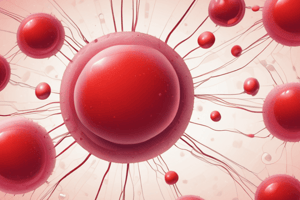Podcast
Questions and Answers
What is the primary function of red blood cells (RBCs)?
What is the primary function of red blood cells (RBCs)?
- To form blood clots
- To fight infections
- To carry carbon dioxide
- To carry oxygen (correct)
Which term describes a decreased white blood cell (WBC) count?
Which term describes a decreased white blood cell (WBC) count?
- Leukopenia (correct)
- Leukocytosis
- Lymphocytosis
- Thrombocytosis
What does the mean cell volume (MCV) measure?
What does the mean cell volume (MCV) measure?
- The diameter of RBCs (correct)
- The total number of RBCs
- The concentration of hemoglobin
- The volume of plasma
Neutrophils are primarily responsible for which function?
Neutrophils are primarily responsible for which function?
What characterizes thrombocytopenia?
What characterizes thrombocytopenia?
Which type of WBC is known for secreting substances like histamine?
Which type of WBC is known for secreting substances like histamine?
What is the primary stain used in the Gram staining procedure?
What is the primary stain used in the Gram staining procedure?
Which test is used to evaluate clotting factors?
Which test is used to evaluate clotting factors?
An eosinophilia condition indicates an increase in which type of WBC?
An eosinophilia condition indicates an increase in which type of WBC?
What does the hematocrit measure?
What does the hematocrit measure?
What type of infection might cause neutrophilia?
What type of infection might cause neutrophilia?
The RDW value indicates which aspect of red blood cells?
The RDW value indicates which aspect of red blood cells?
What type of cell is a macrophage?
What type of cell is a macrophage?
Which bacterial type is classified as gram-negative cocci?
Which bacterial type is classified as gram-negative cocci?
Flashcards are hidden until you start studying
Study Notes
Hematology
- Study of blood cells.
- Includes red blood cells, white blood cells, and platelets.
Red Blood Cells (RBCs)
- Carry oxygen throughout the body.
- Measured in a complete blood count (CBC) using a RBC count, which is the number of cells per cubic millimeter.
- Hemoglobin is the primary constituent of RBC cytoplasm.
- Hematocrit is the ratio of the volume of packed RBCs to the volume of whole blood, measured as a percentage or decimal.
White Blood Cells (WBCs)
- Cells of the immune system.
- Measured in a complete blood count (CBC).
- Leukopenia is a decreased WBC count.
- Leukocytosis is an increased WBC count.
- Differential count reviews and tabulates 100 WBCs on a stained peripheral blood film.
- Types of WBCs include neutrophils, eosinophils, monocytes, basophils, and lymphocytes.
Neutrophils
- Phagocytes for bacteria.
- Have multilobed nuclei (2-5 lobes).
- Their cytoplasm is pink/lavender.
- Neutrophilia is an increase in neutrophils, often caused by bacterial infection.
- Neutropenia is a decrease in neutrophils.
- Band neutrophils are less mature neutrophils with no lobes, shaped like a U or S.
Eosinophils
- Phagocytes for parasites.
- Their cytoplasmic granules are bright orange-red due to proteins.
- Eosinophilia is an increased number of eosinophils, often caused by a parasitic infection.
Basophils
- Secrete histamine and do not phagocytize.
- Their cytoplasmic granules are dark purple, irregular, and obscure the nucleus.
- Basophilia is an increase in basophils.
Lymphocytes
- Phagocytes for viruses.
- The smallest WBCs.
- Types include T cells, B cells, and natural killer cells.
- Provide immunity through cell-mediated and humoral immunity.
- Lymphocytosis is an increased number of lymphocytes, often caused by a viral infection.
- Lymphocytopenia is a decreased number of lymphocytes.
Monocytes
- The biggest WBCs.
- Their cytoplasm is blue-gray with fine azure granules, and their nucleus is usually indented or folded.
- Monocytosis is an increased number of monocytes, often caused by a chronic infection.
- Monocytes are immature macrophages in the blood, becoming macrophages when they go to the tissues.
WBC Order from Most to Least Common
- N-L-M-E-B (neutrophils, lymphocytes, monocytes, eosinophils, basophils).
Platelets (Thrombocytes)
- Cell fragments responsible for primary hemostasis (the initial step in blood clotting).
- Their count determines the number of platelets per cubic millimeter.
- Mean platelet volume (MPV) determines the average size of platelets.
- Thrombocytosis is an increase in platelets.
- Thrombocytopenia is a decrease in platelets.
Coagulation
- Refers to secondary hemostasis, the complex process involving clotting factors.
- Coagulation tests include prothrombin time (PT), partial thromboplastin time (PTT, aPTT), thrombin time, fibrinogen assay, and D-dimer assay.
Microbiology
- The study of microorganisms.
- Involves detection of pathogens from patient samples.
Gram Stain
- Also known as a differential stain.
- Used to select appropriate antimicrobial therapy.
- Uses crystal violet as the primary stain, gram iodine as the mordant, acetone-alcohol as the decolorizer, and safranin as the secondary stain.
Gram-Positive Organisms
- Stain purple.
- Include staphylococcus and streptococcus (cocci), and bacillus (bacilli).
Gram-Negative Organisms
- Stain red.
- Include neisseria (cocci), escherichia (coccobacilli), and pseudomonas (bacilli).
Acid-Fast Stain
- Used for organisms with high lipid and wax content, like Mycobacterium tuberculosis.
- Uses carbon fuchsin as the primary stain, heat (Ziehl-Neelsen) or detergent/tergitol (Kinyoun) as the mordant, acid-alcohol as the decolorizer, and methylene blue or malachite green as the secondary stain.
Direct Sputum Smear Microscopy (DSSM)
- Used to detect infectious cases, particularly tuberculosis.
10% Potassium Hydroxide (KOH)
- Used to detect fungal elements in clinical specimens.
- Clears the specimen of proteinacious and keratinous substances.
Nonselective Media
- Culture media that supports the growth of most nonfastidious microbes.
- Blood agar can be used for hemolysis, resulting in beta (complete, clear zone), alpha (incomplete, grainy zone), or gamma (no hemolysis).
Studying That Suits You
Use AI to generate personalized quizzes and flashcards to suit your learning preferences.



